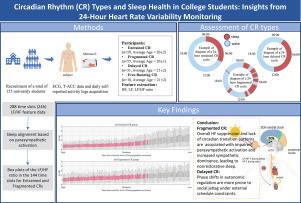Circadian rhythm types and sleep health in college students: Insights from 24-hour heart rate variability monitoring
IF 3.4
2区 医学
Q1 CLINICAL NEUROLOGY
引用次数: 0
Abstract
Circadian rhythm (CR) disruptions are prevalent among college students; however, systematic investigations of autonomic nervous system (ANS) dynamics across distinct CR types remain limited. This study employed a multimodal framework integrating actigraphy and self-reported activity logs to classify 145 college students into three CR types: entrained, delayed, and fragmented. We analyzed 24-hour heart rate variability (HRV) patterns, focusing on high-frequency (HF), low-frequency (LF), and the LF/HF ratio across 288 time slots within a single CR cycle. Non-parametric statistical analyses with Benjamini–Hochberg correction were applied to assess group differences. Results revealed distinct ANS profiles associated with CR stability. The entrained group exhibited robust circadian HRV oscillations, characterized by nocturnal parasympathetic dominance and clear day-night transitions in HF. In contrast, the fragmented group displayed globally suppressed HF, elevated LF/HF ratios, and attenuated circadian rhythmicity, indicative of chronic sympathetic dominance and impaired parasympathetic recovery. The delayed group retained circadian ANS rhythmicity but exhibited a 2–3 h phase delay in nocturnal HF peaks, reflecting misalignment with socially imposed schedules. Temporal analyses of 12-hour HF-defined epochs further demonstrated that only the entrained group exhibited structured transitions between consolidated nocturnal sleep and clustered daytime activity, a pattern absent in fragmented and delayed types. These findings underscore the critical role of CR stability in maintaining ANS equilibrium and sleep health. Targeted interventions that address CR-specific autonomic dysregulation – such as enhancing parasympathetic activity in fragmented type and gradual phase realignment in delayed type – may help mitigate the adverse consequences of circadian misalignment in college populations.

昼夜节律类型与大学生睡眠健康:来自24小时心率变异性监测的见解
昼夜节律(CR)紊乱在大学生中普遍存在;然而,系统的研究自主神经系统(ANS)动力学跨越不同类型的CR仍然有限。本研究采用多模态框架,结合活动记录法和自我报告的活动日志,将145名大学生分为三种CR类型:夹带型、延迟型和碎片型。我们分析了24小时心率变异性(HRV)模式,重点关注高频(HF)、低频(LF)和单个CR周期内288个时隙的LF/HF比率。采用benjamin - hochberg校正的非参数统计分析评估组间差异。结果显示不同的ANS谱与CR稳定性相关。携带组表现出强烈的昼夜HRV振荡,其特征是夜间副交感神经主导和HF明显的昼夜转换。相比之下,碎片化组表现出整体HF抑制,LF/HF比值升高,昼夜节律减弱,表明慢性交感优势和副交感神经恢复受损。延迟组保持了昼夜节律性,但在夜间HF峰值表现出2-3小时的相位延迟,反映了与社会强加的时间表不一致。对12小时hf定义时期的时间分析进一步表明,只有被困组在巩固的夜间睡眠和密集的日间活动之间表现出结构化的转变,而这种模式在碎片化和延迟类型中不存在。这些发现强调了CR稳定性在维持ANS平衡和睡眠健康中的关键作用。针对cr特异性自主神经失调的有针对性的干预措施,如增强碎片型副交感神经活动和延迟型渐进式相位调整,可能有助于减轻大学生群体昼夜节律失调的不良后果。
本文章由计算机程序翻译,如有差异,请以英文原文为准。
求助全文
约1分钟内获得全文
求助全文
来源期刊

Sleep medicine
医学-临床神经学
CiteScore
8.40
自引率
6.20%
发文量
1060
审稿时长
49 days
期刊介绍:
Sleep Medicine aims to be a journal no one involved in clinical sleep medicine can do without.
A journal primarily focussing on the human aspects of sleep, integrating the various disciplines that are involved in sleep medicine: neurology, clinical neurophysiology, internal medicine (particularly pulmonology and cardiology), psychology, psychiatry, sleep technology, pediatrics, neurosurgery, otorhinolaryngology, and dentistry.
The journal publishes the following types of articles: Reviews (also intended as a way to bridge the gap between basic sleep research and clinical relevance); Original Research Articles; Full-length articles; Brief communications; Controversies; Case reports; Letters to the Editor; Journal search and commentaries; Book reviews; Meeting announcements; Listing of relevant organisations plus web sites.
 求助内容:
求助内容: 应助结果提醒方式:
应助结果提醒方式:


